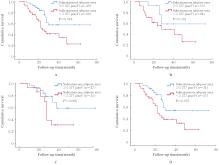吉林大学学报(医学版) ›› 2024, Vol. 50 ›› Issue (4): 1098-1108.doi: 10.13481/j.1671-587X.20240424
多发性骨髓瘤患者胸部CT第4胸椎平面人体成分与预后的关联性分析
- 吉林大学中日联谊医院肿瘤血液科,吉林 长春 130033
Analysis on correlation between body components at T4 thoracic vertebra plane on chest CT in patients with multiple myeloma and prognosis
Xue BAI,Chenchen WANG,Zhangzhen SHI,Lintao BI( )
)
- Department of Tumor Hematology,China-Japan Union Hospital,Jilin University,Changchun 130033,China
摘要:
目的 利用深度学习模型自动分割初诊多发性骨髓瘤(MM)患者胸部CT第4胸椎平面4种人体成分,探讨4种人体成分与MM患者预后的相关性。 方法 对2017年1月-2021年12月于本院确诊的MM患者的临床资料进行回顾性分析,收集患者的年龄、性别、体质量、身高和体质量指数(BMI)等临床信息,收集患者血清中乳酸脱氢酶(LDH)、血钙(Ca)、血肌酐(Scr)、白蛋白(Alb)、血红蛋白(Hb)、β2-微球蛋白(β2-MG)和血清游离轻链水平等实验室数据,利用深度学习模型分别将79例规律进行疗效评价MM患者的胸部CT影像结果分割为胸大肌、胸小肌、皮下脂肪和纵隔脂肪4种人体成分,采用Image J软件分别测量第4胸椎平面4种人体成分面积,分析其与MM患者预后的相关性,并进行Kaplan-Meier生存分析。 结果 单因素分析,皮下脂肪面积、血Ca水平、Scr水平和国际分期系统(ISS)分期与MM患者总生存期(OS)有关(HR=2.260,95%CI:1.116~4.578,P=0.024;HR=2.088,95%CI:1.007~4.327,P=0.048; HR=2.209,95%CI:1.105~4.414,P=0.025;HR=1.730,95%CI:1.040~2.879,P=0.035)。多因素分析,4种人体成分中皮下脂肪面积是影响MM患者预后的独立危险因素(95%CI:1.228~5.782,P=0.013)。Log-Rank检验,在所有患者中,与皮下脂肪面积高值组比较,皮下脂肪面积低值组MM患者OS缩短(P=0.018);在不同性别患者中,皮下脂肪面积高值组与皮下脂肪面积低值组MM患者OS比较差异无统计学意义(P>0.05);在未行造血干细胞移植的患者中,与皮下脂肪面积高值组比较,皮下脂肪面积低值组患者OS缩短(P=0.037)。 结论 第4胸椎平面4种人体成分中,皮下脂肪组织面积与MM患者OS有关,是MM患者预后的独立危险因素,而纵隔脂肪组织、胸大肌和胸小肌面积对MM患者的预后无预测作用。
中图分类号:
- R733.3


